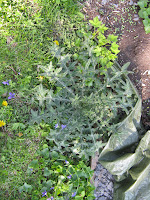 The City of Ottawa has an abundance of ash trees planted throughout the area. It's a hardy tree, does well with little water and doesn't need a lot of maintenance. Because of this, it's popular in subdivisions (ie Barrhaven) and downtown Ottawa, along with Linden and Ivory Silk Lilac trees. However, as time has proven again and again, the planting of one main tree in an area will result in infestation of pests and pathogens (ie Dutch Elm Disease).
The City of Ottawa has an abundance of ash trees planted throughout the area. It's a hardy tree, does well with little water and doesn't need a lot of maintenance. Because of this, it's popular in subdivisions (ie Barrhaven) and downtown Ottawa, along with Linden and Ivory Silk Lilac trees. However, as time has proven again and again, the planting of one main tree in an area will result in infestation of pests and pathogens (ie Dutch Elm Disease). You can tell if your tree is infested by looking for obvious loss of leaves and dead branches in the UPPER part of the tree, unusually thin tree crowns (sparse 'Charlie Brown' look) and branch/leaf growth in the lower part of the stems not seen before (severe suckering). Look for bark splitting, S-shaped grooves beneath the bark and the D-shaped exit holes are 3.5-4mm wide.
You can tell if your tree is infested by looking for obvious loss of leaves and dead branches in the UPPER part of the tree, unusually thin tree crowns (sparse 'Charlie Brown' look) and branch/leaf growth in the lower part of the stems not seen before (severe suckering). Look for bark splitting, S-shaped grooves beneath the bark and the D-shaped exit holes are 3.5-4mm wide. 
 The borer spreads by flying short distances, which isn't that big of a deal. However, due to transportation of infected ash wood/boards, it has spread. The City of Ottawa asks the public not to move firewood or other wood materials. To reduce the risk of spread, burn firewood locally, and buy your ash locally. There is a pesticide which was developed by the Canadian Forest Service but it must be injected by a professional. You can reach BioForest at 1-888-236-7378 or at http://www.bioforest.ca/
The borer spreads by flying short distances, which isn't that big of a deal. However, due to transportation of infected ash wood/boards, it has spread. The City of Ottawa asks the public not to move firewood or other wood materials. To reduce the risk of spread, burn firewood locally, and buy your ash locally. There is a pesticide which was developed by the Canadian Forest Service but it must be injected by a professional. You can reach BioForest at 1-888-236-7378 or at http://www.bioforest.ca/
If you suspect your tree is infected, contact the Canadian Food Inspection Agency (CFIA) toll free: 1-866-463-6017 or e-mail at 311@ottawa.ca
Hope you learned lots.
